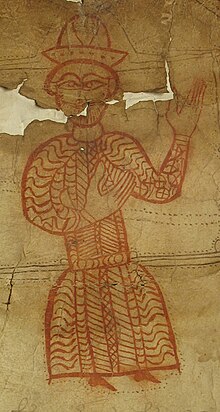George VII of Georgia
| George VII გიორგი VII | |
|---|---|
 | |
| King of Georgia | |
| Reign | 1393–1407 |
| Predecessor | Bagrat V |
| Successor | Constantine I |
| Born | 1360s |
| Died | 1407 |
| Burial | |
| Spouse | Nestan-Darejan |
| Dynasty | Bagrationi |
| Father | Bagrat V of Georgia |
| Mother | Helena Megale Komnene |
| Religion | Georgian Orthodox Church |
| Khelrtva |  |
George VII(Georgian:გიორგი VII,romanized:giorgi VII) (died 1405 or 1407) of theBagrationi dynasty,wasking(mepe) ofGeorgiafrom 1393 to 1407 (alternatively, from 1395 to 1405).[1]George put up a stiff resistance and had to spend much of his reign fighting againstTimur.
Biography[edit]
Early life and co-ruler[edit]
George was the son of theGeorgianKingBagrat Vand his first wifeHelena Megale Komnene(died ofbubonic plague,1366).[2]Bagrat appointed him co-ruler in 1369.[3]
WhenTbilisifellon 22 November 1386, its inhabitants were massacred and Bagrat fell into captivity.Timur'sarmy spent the winter inKarabakh.To regain his freedom, Bagrat pretended to convert toIslamandTimursent him back under surveillance of a 12,000 strong army which was to enforce theGeorgian Kingdom'sconversion to islam. Bagrat secretly informed his son George, who raised an army and destroyed the Timurid troops, and freed Bagrat.[4]
In 1392,George I of Imeretiwas killed during campaign againstVameq I Dadiani,allowing Prince George to unite with the great feudal lords of the West Georgia and invade the rebellious territories. TheKingdom of Western Georgiawas annexed byKingdom of Georgia,while the surviving members of the rebel family took refuge in theCaucasus Mountains.[5][6][7]
Reign[edit]

In 1393,Bagratdied and George assumed full royal powers. He spent most of his reign fightingTimurwho led seven more expeditions against the stubbornGeorgian kingdomfrom 1387 to 1403, leaving the country in ruins.
In 1396,Constantinewho has been exiled to theNorth Caucasustook advantage of theTimurid invasions of Georgiaand the death ofVameq I Dadiani,he returned toImeretiand organized a new rebellion.[5]Without much resistance, the new rebel captured numerous fortresses and had himself crownedConstantine II of Imereti,but failed to unite with the region's great feudal lords. After demanding the vassalization of the dukes ofSvaneti,MingreliaandGuria,but he was killed in 1401. As Constantine was childless, the crown of theKingdom of Western Georgiawas to be passed on to his young and weak nephew,Demetrius,George VII who took advantage of a temporary ceasefire withTimurto invade western Georgia and once again put an end to the separatist kingdom.[8][9][10]
In 1399, George VII gathered theGeorgian,North Caucasians(Simsim), andShakiarmy and attacked theTimuridbesiegers. They rescued Tahir and freed some of those inside the castle,Miran Shah'sgeneral Seif ad-Din fleed toTabriz.[4][3]Sidi Ahmad Ogulsai and three Georgian nobles took Tahir's place inside the fortress.[11]While the Georgian army was withdrawing, an army sent by Miran Shah under the command of his sonAbu Bakrarrived and a battle broke out. The Georgians attacked and although Sayyid Ali was killed by an arrow, the Timurid army was defeated. Abu Bakr retreated to Tabriz.[3][12]
This event prompted Timur to return in 1399. He capturedShakiand devastated the neighboring region ofHeretiandKakheti.[13]In the spring of 1400, Timur moved back to destroy the Georgian state once and for all. He demanded that George should hand over theJalayiridTahir but George refused with explanation that this would be against the Caucasian traditions and met Timur at the Sagim River inKvemo Kartli,but suffered a defeat.[14]After the war, of those who survived the fighting and reprisals, many thousands died of hunger and disease, and 60,000 survivors were enslaved and carried away by Timur's troops.[15]
In late 1401, Timur invaded the Georgia once again.[16]George VII had to sue for peace, and sent his brotherConstantinewith the contributions. Timurmade peace with Georgeon condition that the King of Georgia supplied him troops during his campaign againstOttoman Empireand granted theMuslimsspecial privileges.[17]Once the Ottomans were defeated at theBattle of Ankara,Timur, back toErzurumin 1402, decided to punish George VII for not having come to present his congratulations on his victory. Historians reported that 700 towns were destroyed and their inhabitants massacred by Timurid forces.[18][19]
In the aftermath of Timur's death in February 1405 and the subsequent power struggles among his heirs, Timur's empire became fragmented asMiran Shahand his sons struggled over control ofPersia.In the midst of this chaos, George, who had returned from Imereti, engaged in battles to regain lost territories. He managed to conquerNakhchivanandGanjawhile also causing destruction in places likeAni,Erzurum,andTabriz.Despite commanding an army of merely 5,000 men, George succeeded in expanding Georgia's borders temporarily to their former extent.[20]
According toVakhushti of Kartli,He was killed in battle against theTurkomannomads, apparently of theQara Qoyunluclan. Today, some historians consider this information of Vakhushti doubtful and claim that George VII died of natural causes.[21]
George VII may have died childless, as his brotherConstantine Ibecame the next king.
See also[edit]
References[edit]
- ^Kʻartʻuli diplomatiis istoriis narkvevebi(in Georgian). Tʻbilisis universitetis gamomcʻemloba. 1998. pp. 530–543.ISBN978-5-511-00896-7.
- ^Ivane Javakhishvili, The History of the Georgian Nation, vol. 3, Tbilisi, 1982, p.180
- ^abcRayfield 2012,p. 149.
- ^abBaumer 2023,p. 75.
- ^abBrosset 1856,p. 248.
- ^Bagrationi, Vakhushti(1976). Nakashidze, N.T. (ed.).История Царства Грузинского[History of the Kingdom of Georgia](PDF)(in Russian). Tbilisi: Metsniereba. pp. 129–130.
- ^Toumanoff, Cyril(1949–51). "The Fifteenth-Century Bagratids and the Institution of Collegial Sovereignty in Georgia".Traditio.7:183.
- ^Brosset 1856,p. 249.
- ^Toumanoff, Cyril(1949–51). "The Fifteenth-Century Bagratids and the Institution of Collegial Sovereignty in Georgia".Traditio.7:183.
- ^Bagrationi, Vakhushti(1976). Nakashidze, N.T. (ed.).История Царства Грузинского[History of the Kingdom of Georgia](PDF)(in Russian). Tbilisi: Metsniereba. pp. 41–42.
- ^Minorsky 1930,p. 95.
- ^Javakhishvili 1949,p. 193.
- ^Hodong Kim, "The Early History of the Moghul Nomads: The Legacy of the Chaghatai Khanate."The Mongol Empire and Its Legacy.Ed. Reuven Amitai-Preiss i David Morgan. Leiden: Brill, 1998.
- ^Mirza Muhammad Haidar.The Tarikh-i-Rashidi (A History of the Moghuls of Central Asia).Traduit per Edward Denison Ross, editat per N. Elias. Londres, 1895.
- ^Minorsky, Vladimir,"Tiflis", in: M. Th. Houtsma, E. van Donzel (1993),E. J. Brill's FirstEncyclopaedia of Islam,1913–1936,p. 757. Brill,ISBN90-04-08265-4.
- ^Beatrice Forbes Manz,The Rise and Rule of Tamerlane.Cambridge University Press: Cambridge, 1989.ISBN0-521-63384-2
- ^Sicker, Martin (2000),The Islamic World in Ascendancy: From the Arab Conquests to Siege of Vienna,p. 155. Praeger,ISBN0-275-96892-8.
- ^The Empire of the Steppes: A History of Central Asi
- ^Minorsky, Vladimir,"Tiflis", in: M. Th. Houtsma, E. van Donzel (1993),E. J. Brill's FirstEncyclopaedia of Islam,1913–1936,p. 757. Brill,ISBN90-04-08265-4.
- ^Rayfield 2012,p. 152.
- ^Tavadze, L. (2008) About the reasons of Georgian King George VII death, Studies in the Middle Ages History of Georgia, Vol. IX. p. 41–45ISBN978-9941-12-174-6
Sources[edit]
- Baumer, Christoph (2023).History of the Caucasus.Bloomsbury Publishing.ISBN9780755636303.
- Brosset, Marie-Félicité (1856).Histoire de la Géorgie depuis l'Antiquité jusqu'au XIXe siècle - IIe partie: Histoire moderne.Saint Petersburg Academy of Sciences.
- Javakhishvili, Ivane (1949).Histoire de la Géorgie. XIe – XVe siècles(in Georgian). Tbilisi: Publication d'État de la RSS de Géorgie..
- Minorsky, Vladimir(1930).Transcaucasica(in French).Librairie orientaliste Paul Geuthner.
- Rayfield, Donald (2012).Edge of Empires: A History of Georgia.Reaktion Books.
Further reading[edit]
- ჯავახიშვილი ივ., ქართველი ერის ისტორია, წგ. 3, თბ., 1982 (თხზ. თორმეტ ტომად, ტ. 3).
- კაციტაძე დ., საქართველო XIV–XV საუკუნეთა მიჯნაზე, თბ., 1975;
- ტაბატაძე კ., ქართველი ხალხის ბრძოლა უცხოელ დამპყრობთა წინააღმდეგ XIV–XV საუკუნეების მიჯნაზე, თბ., 1974;
- ოდიშელი ჯ., აღმოსავლეთ საქართველოს პოლიტიკური ისტორიისათვის (XIV–XVII სს.), კრ.: XIV–XVIII სს. რამდენიმე ქართული ისტორიული დოკუმენტი, თბ., 1964;
- გვრიტიშვილი დ., ნარკვევები საქართველოს ისტორიიდან (XIII–XIVსს.), თბ., 1962;
- გაბაშვილი ვ., თათართა შემოსევები საქართველოში (ბაგრატ V და გიორგი VI), თბ., 1943;
